 |
 |
|
 |
Five tribes, Mn/DOT sign agreements on employment practices |
 |
 |
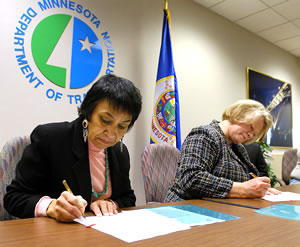 |
|
Erma Vizenor, tribal chair of the White Earth Band, and Lt. Gov/Commissioner Carol Molnau sign the TERO agreements in St. Paul on Feb. 17. Photo by David Gonzalez |
Five of the 11 federally recognized Indian tribes in Minnesota signed agreements with Mn/DOT to encourage increased employment of Indian people on highway and other transportation projects.
The signing ceremony was held in the Central Office by Lt. Gov./Commissioner Carol Molnau and tribal leaders Feb. 17. The agreements specify how Mn/DOT and each tribe will work to promote hiring Indian people on state- or federally funded projects done on reservation lands or within a reasonable commuting distance.
For example, the department and the tribes will meet annually to review short- and long-range project planning and to identify which projects should receive special attention to increase Indian employment, said Linda Aitken, Mn/DOT’s tribal liaison.
Tribal leaders signing the agreements on Feb. 17 were from the Leech Lake Band of Ojibwe Indians, Red Lake Band of Chippewa, Shakopee Mdewakanton Sioux Community, the Upper Sioux Community and the White Earth Band of Ojibwe.
The tribes will identify tribal members who have skills needed for the project or recruit members for on-the-job training. The tribes will also work with the trade unions to establish their requirements for tribal members working on transportation projects where the contractor has an agreement to hire union workers.
The set of agreements follows the Tribes and Transportation Accord reached in 2002 by Mn/DOT, the tribes and the Federal Highway Administration to attain several goals, including increased Indian employment on transportation projects.
Molnau said the agreements underscore the department’s and the FHWA’s goals to increase Indian employment.
“These agreements are a significant first step to widen Indian employment and to meet the goals adopted by each tribe,” she said “They’re milestones that mark our coming together and working together to solve our mutual problems and concerns.”
Some of the tribes have adopted tribal employment rights ordinances that set forth ways to maximize employment for Indian people.
Nationwide, more than 300 Indian tribes and Alaskan Native villages have adopted TEROs. In Minnesota, six of the 11 recognized tribes have established the ordinances.
George Goggleye, Jr., chair of he Leech Lake Band, said the tribes’ signing marks a step forward for Indian employment opportunities.
“This agreement represents the spirit of the Tribes and Transportation Accord,” Goggleye said, “and will provide new opportunities for tribal members for training, skill development and employment.”
By Craig Wilkins
|
back

|
 |
Metro, Windom test ‘lawn chair’ style webbed, plastic snow fences |
 |
 |
 |
|
The Metro District installed a snow fence on the I-94/I-694 Fish Lake interchange in Maple Grove. It uses a flexible, webbed fencing attached to steel posts 12 feet high set in concrete to blunt the wind’s force and reduce drifting and blowing snow. Photo by Kent Barnard |
A snow fence longer than a football field and as high as a basketball hoop is getting a workout this winter in the Twin Cities to see how well it performs.
The Metro District installed the fence on the Interstate 94/I-694 Fish Lake interchange in Maple Grove. The fence is 350 feet long and 10 feet high. It uses a flexible, webbed fencing attached to steel posts 12 feet high set in concrete to blunt the wind’s force and reduce drifting and blowing snow and ice build-up on the bridge.
Along I-90 near Jackson, the fence installed by the Windom/District 7 Maintenance Area is a bit lower—eight feet—but extends for more than a quarter of a mile along the freeway’s westbound lanes. Unlike the Metro District fences, Windom’s installation uses wooden instead of steel poles.
The fencing was first used in western states such as Wyoming to contain cattle, but later were adapted for snow fence use when ranchers discovered they effectively controlled drifting on adjacent highways.
George Welk, Windom maintenance engineer, said the district also built a similar fence three years ago on Hwy 14 near Cobden in Brown County.
Jerry Krebs, maintenance sub-area supervisor at St. James, said the fence protects a section of Hwy 14 just west of Cobden that was particularly vulnerable to drifting.
“Before we installed the fence, the snow would whip across a field and dump right on the highway,” he said.
Krebs said Windom had previously built two wooden snow fences on Hwy 14 near Springfield and recently planted dogwood and other shrubs to create a living snow fence on Hwy 14 at Cobden. The living snow fence, he said, protects the new Hwy 14 bridge over the Sleepy Eye River .
Wooden fences have proved effective, but the “lawn chair” design is easier to repair and is much more flexible.
For example, maintenance crews can change the webbing’s spacing to alter the wind’s speed and direction through the fence. That way, Welk said, they can measure which level of porosity works best in a given set of weather conditions.
“The fence’s job is to grab the snow right out of the air,” Welk said.
Although snowfall during the 2004-05 winter has been scant in the southern half of the state, Welk is confident that the webbed, plastic fences will work well during heavy snows and strong winds as long as they are placed correctly.
“We’ve only had seven or eight inches of snow a few inches at a time this winter,” he said, “but I’ve seen enough with our previous installations that I believe the newer ones will function very well.”
By Craig Wilkins (Kent Barnard and Cathy Ashfeld, Metro District, also contributed to this article.)
|
back

|
 |
Lower-cost, solar-powered warning systems tested at railroad crossings |
 |
 |
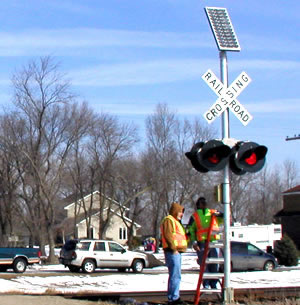 |
|
Mn/DOT is testing a new solar-powered railroad warning system that can make rail crossings safer at a much lower cost than traditional warning systems. |
Mn/DOT is testing a new solar-powered railroad warning system that can make rail crossings safer at a much lower cost than traditional warning systems.
The current warning systems, with flashing lights and drop-down gates, cost as much as $150,000. The new system, which will be as visible and effective as the traditional version, could cost as little as $15,000 to install.
The new system has been developed over the last four years through a collaboration of Mn/DOT, the Federal Railroad Administration, the Twin Cites and Western Railroad and the C3 Trans System company (a Blaine-based business that builds rail crossing warning systems).
“The system costs less because it is solar powered,” said Brad Estochen, who manages the project for Mn/DOT. “It doesn’t have to be wired into a power grid, and it will fit onto existing cross-buck signs.”
Estochen said the goal of the project has been to develop a product that provides the same warning capability as traditional systems but at a lower cost. A smaller price tag means warning systems can be installed at lower volume highway-rail intersections, which is where 70 percent of all rail-highway fatalities occur in Minnesota, according to Department of Public Safety statistics.
To activate the system, an oncoming train engineer sends a radio signal from the locomotive to the signal system from about a mile away. The system is activated and drivers get a 30-second warning before the train reaches the intersection.
Estochen said the system is undergoing testing in 27 sites on the Twin Cites and Western rail system for several months. The testing is looking at operational performance, cost and reliability as well as the maintenance implications. Once it has proven that it works, the Federal Railroad Administration will determine whether the new system meets federal performance standards.
Then, railroad companies would need to do some things to accommodate the system, including installing radio transmitters in locomotives and training technicians to service the warning systems.
“The initial testing that we’ve done over the last couple of years has been very positive,” Estochen said. “I think the final round of testing should show that this is a viable option for the lower-volume crossings.”
By Kevin Gutknecht
|
back

|
 |
White Earth Band, District 4, other agencies plan new Hwy 59 welcome center near Detroit Lakes |
 |
 |
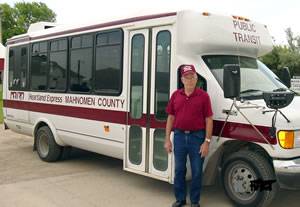 |
|
Mahnomen County will provide transit service from the city of Mahnomen to the new Hwy 59 welcome center and the Detroit Lakes area. |
Sharing resources will enable the White Earth Band of Ojibwe, Becker County, the Area Transportation Partnership and Mn/DOT to build a distinctive, multi-purpose welcome center on Hwy 59 three miles north of Detroit Lakes.
Officials will sign a memorandum of understanding on March 8 to specify each partner’s contributions to the project.
As planned, the welcome center will include a Mn/DOT rest area accessible by people who have disabilities and a visitors center operated by the band. The center will include a reception area, information counter, a gift shop and other retail space.
Mn/DOT and the band will own the 2,500 square foot building and its 20-acre site. The band will use $700,000 of a $1 million federal transportation grant to purchase its share of the facility. Total cost of the facility will be about $1.4 million.
Partners expect completion of the project in 2008.
The site, previously used as a gravel pit by the county, will be landscaped to improve its appearance and create a buffer zone to separate it from adjacent residential areas.
The facility will also have a park and ride lot and a waiting area for passengers who could transfer from the tribal bus system to the transit systems operated by counties in the region, said Keven Anderson, District 4’s transit manager. Becker County Transit will provide shuttle service for riders in the Detroit Lakes area.
Mn/DOT’s Site Development Unit in the Office of Technical Support will design the rest area and visitors center.
Anderson said White Earth will use about $300,000 of its grant to build a garage and purchase a small fleet of buses to serve the reservation area.
Becker County Transit will provide shuttle service for riders in the Detroit Lakes area, he said. Mahnomen County will provide transit service from the city of Mahnomen to the reservation and the welcome center. Clay County ’s transit service will stop at the center to take passengers on to Fargo-Moorhead.
“From the welcome center,” Anderson said, “a bus rider could transfer to other county transit systems and travel to Detroit Lakes or the Fargo-Moorhead metropolitan area.”
Lee Berget, district engineer at Detroit Lakes, said the new facility will benefit both area residents and visitors to the region.
“In addition to improving convenience and safety for travelers, the visitors center will help visitors value the reservation and its people and further explore the region and its resources," he said. “The visitors center represents combining our resources for the betterment of all, whether that means supporting tourism or enabling area residents better access to job opportunities in Detroit Lakes and the Fargo-Moorhead metropolitan area."
By Craig Wilkins
|
back

|
 |
Photographer, plow operator take tools of their trades to grammar school classes |
 |
 |
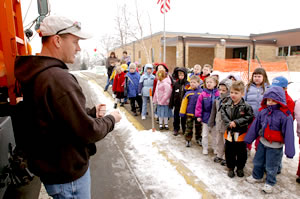 |
|
Jason Penaz demonstrates the workings of a Mn/DOT snowplow during his visit with children at the school. Photo by David Gonzalez |
Photographer David Gonzalez put his camera bag down and switched from picture taking to picture explaining during a visit to the Hanover Elementary School on Feb. 26.
Gonzalez, a photographer with Administrative Services, was there to share his experience of taking photos that were used to illustrate a children’s book about building highways.
A Mn/DOT employee since 1978, Gonzalez knows a lot about both.
Gonzalez was invited to attend the annual career day event after Susan Cahill, Metro District employee and parent of a Hanover kindergartner, recommended his appearance to school officials. He read from the book, “From Rock to Road,” and demonstrated a few photo techniques.
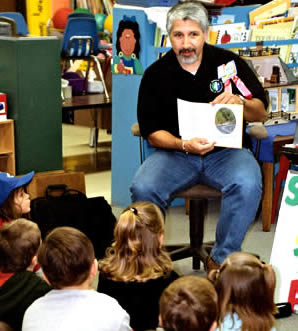 |
David Gonzalez reads from “From Rock to Road” with young listeners at the Hanover Elementary School. Photo by Susan Cahill |
Cahill, with the aid of Cathy Clark, District 3 public affairs coordinator, also helped arrange a visit by Jason Penaz, a transportation worker at District 3’s nearby Monticello Truck Station. Penaz brought a huge visual aid—a freshly washed and very orange tandem-axle snowplow.
Penaz demonstrated the plow’s operation and stressed the need for safety when children play in areas close to where plows operate. He also allowed the children to climb into the plow’s high-tech cab and sit behind the wheel for a few moments.
Gonzalez and Penaz joined a diverse group of readers including Secretary of State Mary Kiffmeyer; Commissioner of Education Alice Seagren; Tom Gillaspy, state demographer; a Vikings cheerleader, a physician and a police officer.
The children, Cahill said, were mesmerized by the day’s presenters.
“That’s no small task, especially for Dave, Jason and Tom, who had kindergartners as their audience,” she said.
By Craig Wilkins
|
back

|
 |
Leukemia claims life of Information Technology’s John Hajek |
 |
 |
 |
|
John Hajek, Information Technology, worked for Mn/DOT since 1969. Shown here in 1996, Hajek died Feb. 26 of complications of leukemia. |
A funeral service was held March 2 for John C. Hajek, Information Technology, who died Feb.26 of complications from leukemia. He was 56. The illness was discovered after Hajek was hospitalized for pneumonia on Feb 20.
Hajek, an information technology specialist 4, joined Mn/DOT in 1969. His 36-year career with the state also included service with the Intertechnologies Group in the Department of Administration.
He was a lifelong resident of Inver Grove Heights and had coached American Legion baseball and hockey at Simley High School. In addition, he played an active role in the state bargaining units and currently served as treasurer of Local 801 of the Minnesota Association of Professional Employees. He also served as past president of Local 801 and was recently elected chief steward of Local 801 and 802.
His former co-workers said he possessed a generous spirit and a kind heart.
“John was a very giving person who was always there to help you move, to listen or to play golf,” said Patti Lopez of IT.
Added Kim Killeen, “John was a very kind-hearted person; he was always there to help anyone in any way they needed.”
Bob Richards, Construction and Innovative Contracting, a fellow MAPE official, said Hajek had a very compassionate nature.
“He was generous, very giving of himself and always willing to help people in need,” Richards said.
Hajek’s parents preceded him in death. Survivors include cousins, close friends, co-workers and fellow union members.
|
back

|
 |
|
 |



